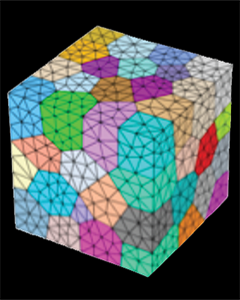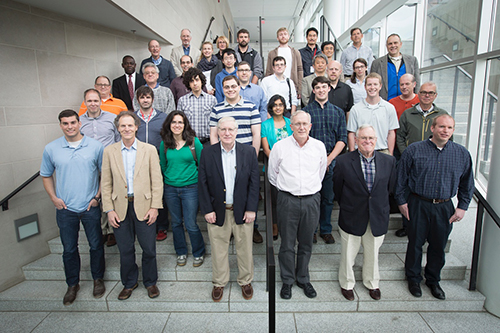X-RAY RUNS: Apply for Beamtime
2017 Nov 1 - Dec 21
2018 Feb 7 - Apr 3
2018 Proposal/BTR deadline: 12/1/17
2018 Apr 11 - Jun 4
2018 Proposal/BTR deadline: 2/1/18

Six summer science workshops at CHESS followed a most memorable Users’ Meeting on June 7th when our user community first heard the big news about plans to reconfigure the accelerator and beamlines to use only a single source of particles. This will involve relocating the five experimental stations on the A, B, C, and D beamlines, and upgrading the replacement stations with independently tunable high-flux undulator sources. The goal of the workshops is to identify the most pressing and important scientific needs for a future high-energy x-ray source utilizing unique capabilities of the Cornell accelerator and special types of organization and user support.
This “structural materials” workshop was held on June 8th and 9th and involved 15 invited speakers and 39 attendees. In addition, 14 remote viewers asked questions and participated in discussions through the on-line YouTube stream. The local organizing committee consisted of Armand Beaudoin (UIUC) and Matthew Miller (Cornell), with outside organizes Margaret Koker (GSECARS/Argonne) and committee chair Paul Shade (Air Force Research Laboratory). The organizers invited academic and industrial partners to ponder how high-energy x-rays can help characterize residual stress as well as capture kinetic processes during life-cycle testing and Additive Manufacturing (AM).
The full agenda for the workshop with speakers’ names and presentation titles and abstracts are available online here: http://meetings.chess.cornell.edu/sciworkshops2016/Workshop1.html
Understanding residual stress in manufactured components was a particular focus of participants from American industry, including Caterpillar, Alcoa, and General Electric, who provided insight into how CHESS can be utilized to strengthen (and lighten!) the products in which they produce. Speakers from NASA and the Air Force Research Laboratory need to understand structural integrity in components used in high strain, high stress situations. For example, Douglas Wells (NASA) discussed in-situ strain measurements to provide improved understanding of damage tolerance at the microstructural scale, showing how solid state welding employed by NASA produces a tremendous residual stress in materials.
Continuing that theme, evaluating welds with high-energy x-rays could greatly improve their understanding of this complex process and make a stronger and more durable component. Justin Mach (Caterpillar) gave examples of the successes that his company has had collaborating with CHESS using high-energy x-ray diffraction techniques to improve Caterpillar’s manufacturing processes and product performance. Speakers from Rutgers, Ohio State University and Michigan State University provided insight to the ongoing research and promoted the theme that permeated throughout all of the speakers; the importance of industrial and academic interaction for a successful Materials Genome Initiative (MGI). The higher-energy and higher-flux resulting from the CHESS-U upgrade could enable these measurements to become a standard by which industrial processes and products are validated and improved.
Additive Manufacturing (AM), better known as 3D printing, was a second major theme. James Williams (Ohio State) presented the appeal of AM while also exposing the technical and economic barriers to its success. High energy x-rays have the penetrating power to determine the stress caused by AM, concluding that high fidelity modeling, consistent with the federal Materials Genomics Initiative, is needed to validate this new manufacturing process.
After the meeting, CHESS scientists, organizers and participants joined forces to summarize notes and compose “white papers,” capturing the scientific need and opportunities for innovative work using an upgraded CHESS source. CHESS scientists are now working with members of the CHESS External Advisory Committee and members of the CHESS Users’ Executive Committee to refine, combine, reduce and/or sharpen the ideas captured from the workshops. The CHESS staff is enormously grateful to members of the user community and beyond who’ve helped shape the future of CHESS.
Stay tuned to the CHESS eNewsletter to hear exciting updates on the CHESS-U upgrade.

Participants at Workshop 1 in the Physical Sciences Building.
Submitted by:
Ernest Fontes and Rick Ryan, CHESS, Cornell University
07/13/2016
